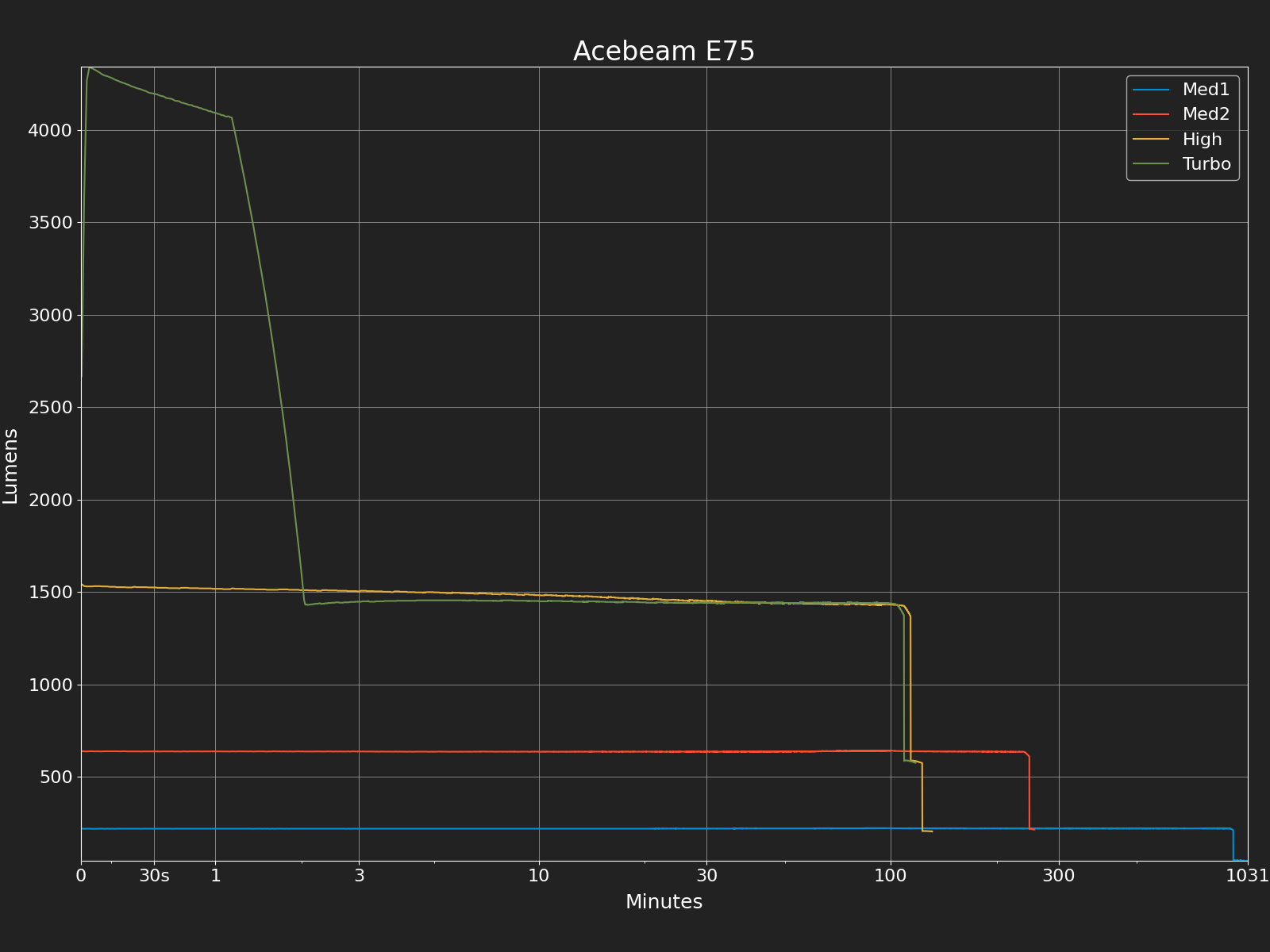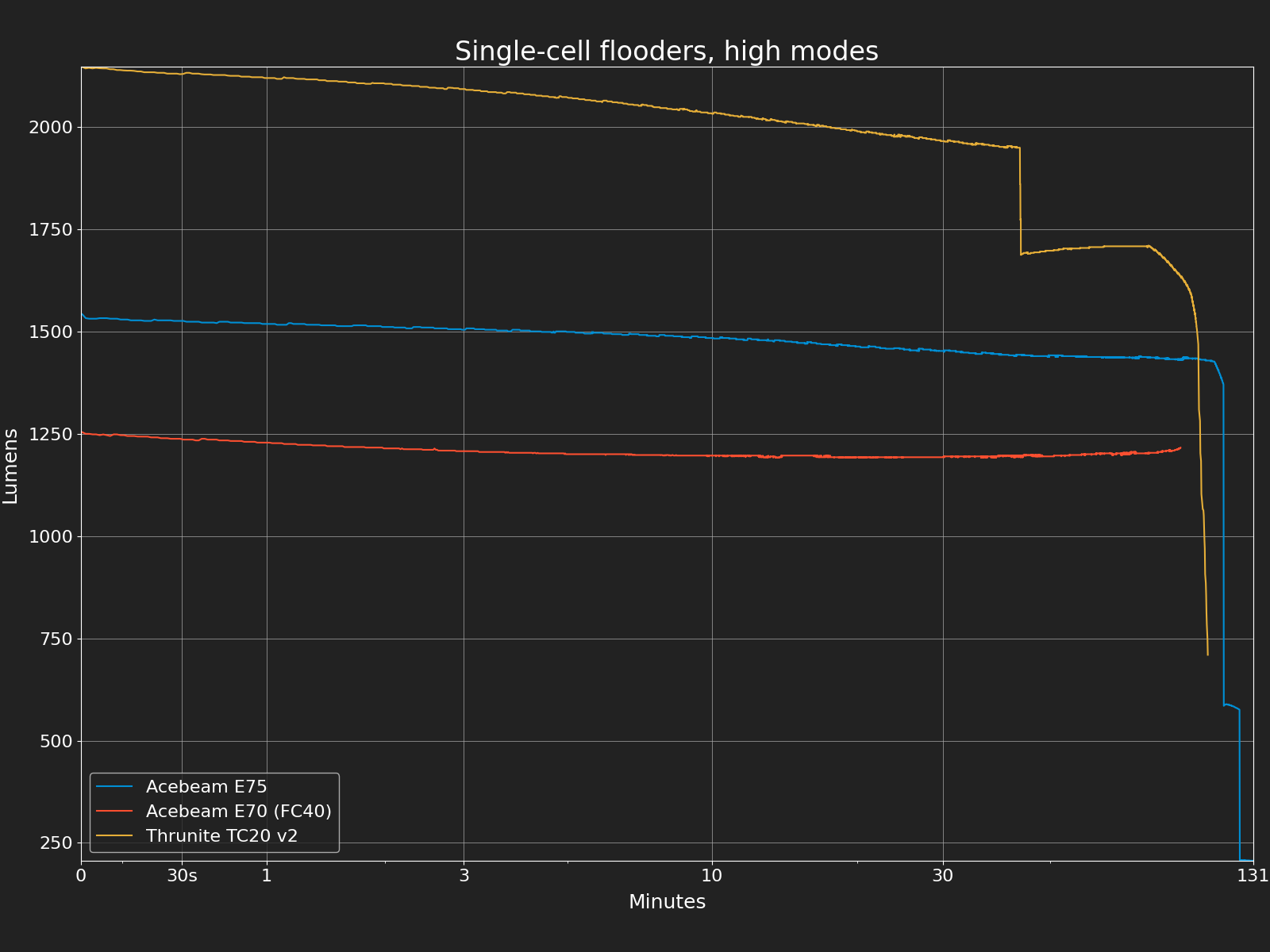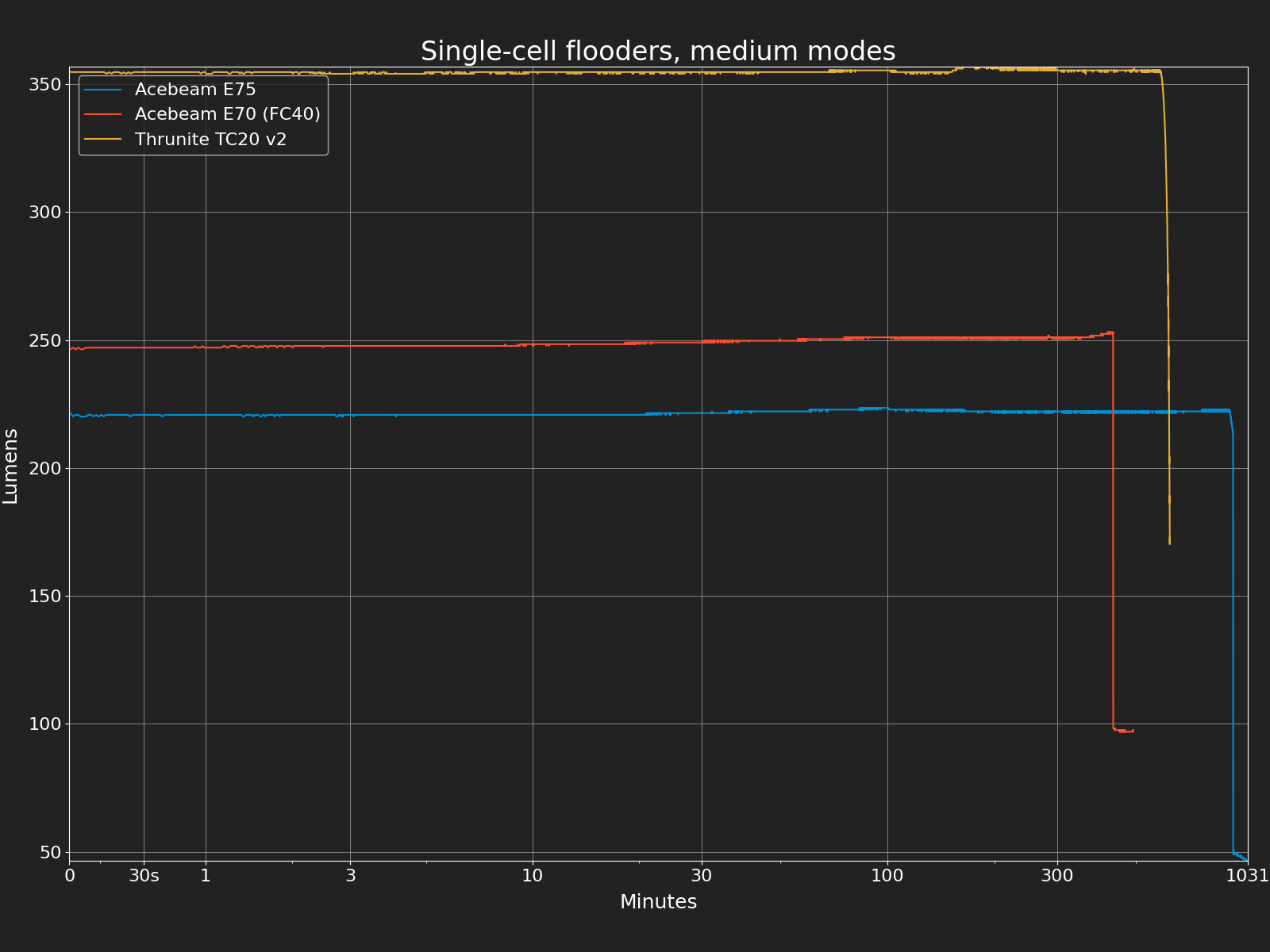This Acebeam E75 (affiliate link) was provided by Acebeam for review.
Overview
The Acebeam E75 is a general-purpose floody flashlight with a 21700 battery, USB-C charging, a strong magnet in the tailcap, excellent efficiency and color quality. It struck me as a bit boring when it was first announced, but it's the best kind of boring; it does its job very well with no surprises and easily justifies its price.
Most people will find the E75 too large for carry in a pants pocket, but it's a good size for a jacket pocket or backpack. The beam is on the floody side, but provides adequate throw for most general use situations on higher modes. The color temperature is on the cool side, but the color rendering is excellent, and the look resembles midday sunlight. It will get warm in the process, but it's capable of maintaining its 1526 lumen high mode for over 100 minutes until the battery runs out, but there's plenty of warning from the colored LEDs surrounding the switch.
It's hard to find anything to complain about with the E75, but I'll try: the button doesn't provide much tactile feedback, and unprotected cells can rattle, or disconnect if the light is shaken vigorously. I love it when my worst complaints about a flashlight are such minor issues.
It's rare I get to write this: the Acebeam E75 is outstanding.
Specifications
| Spec | - |
|---|---|
| Battery | 1x21700 |
| LED | Nichia 519A, or unspecified cool white LED |
| Color temperature | 5873K |
| Color rendering index | 96 |
| Max output | 4195 lm |
| Max throw | 214 m |
| Max sustainable output | 1526 lm |
| Max output at 50% battery | 2651 lm |
| Best efficiency | 190 lm/W @ 221 lm |
| Candela per lumen | 2.6 (very floody) |
| Length | 129mm |
| Head diameter | 35mm |
| Weight | 145g |
| Weight with battery | 217g |
| Water resistance | IP68 (2m submersible) |
| Charging | USB-C |
| Low Voltage Protection (LVP) | Yes, 2.7V |
| Lockout | Mechanical and electronic |
| Approximate price | $100 |
| Rating | ★★★★★ (outstanding) |
Highlights
- Very efficient
- Excellent color rendering
- Balanced beam profile
- Great build quality
- Strong magnet
Lowlights
- Unprotected flat-top batteries can rattle and break contact
- Button feel is mushy and unsatisfying
Details and technical analysis
Versions
The E75 comes in black, grey, green, and teal with a choice of Nichia 519A or unspecified cool-white LEDs. This is the teal, 519A version.
Accessories
The E75 comes with a battery, USB A-C cable, spare O-rings, spare USB port cover, and lanyard. Optional, and highly recommended for their trivial cost are red and white traffic wand style diffusers.
Modes and user interface
Modes
| Mode | Estimated lumens | Estimated throw (FL1 meters) |
|---|---|---|
| Moonlight | 1 | 3 |
| Low | 51 | 23 |
| Med1 | 221 | 47 |
| Med2 | 639 | 80 |
| High | 1526 | 127 |
| Turbo | 4195 | 214 |
User Interface
| State | Action | Result |
|---|---|---|
| Off | Click | Last-used (L/M/H) |
| Off | Hold | Moonlight |
| On | Hold | Cycle L/M/H |
| Any | Double-click | Turbo |
| Any | Triple-click | Strobe |
| Turbo | Double-click | Last-used |
| Off | Hold 3S | Lockout |
| Lockout | Hold 3S | Moonlight |
There is a mechanical lockout by slightly loosening the tailcap.
Output, runtime, and efficiency
Tests were conducted using a Samsung 50S 5000 mAh 21700 battery. I should note some of these lumen readings seem a little optimistic to me.
Turbo on the E75 has an unusual soft start, taking a few seconds to reach full output. A casual user might think it's not as bright as it really is.
| Mode | Estimated lumens |
Time to 80% | Time to 50% | Time to 10% | Efficiency (lm/W) |
Current (mA) |
|---|---|---|---|---|---|---|
| Moonlight | 1 | 1.2 months | 41 | 6 | ||
| Low | 51 | 3.0 days | 180 | 69 | ||
| Med1 | 221 | 15.7 hours | 15.7 hours | 17.2 hours | 190 | 277 |
| Med2 | 639 | 4.1 hours | 4.1 hours | 4.5 hours | 149 | 823 |
| High | 1526 | 114 minutes | 114 minutes | 2.4 hours | 161 | 2373 |
| Turbo | 4195 | 1.4 minutes | 1.9 minutes | 2.0 hours | 159 |

The E75 compares well to other floody lights using 5000 mAh batteries:


Light quality
Readings are taken from the center spot diffused with DC Fix diffusion film using an X-rite i1Pro spectrophotometer.
| Mode | Color Temperature |
Tint Duv | CRI | CRI R9 (deep red) |
CRI R12 (deep blue) |
|---|---|---|---|---|---|
| Moonlight | 5589K | 0.0018 (slightly green) | 95.8 | 97.6 | 75.8 |
| Low | 5722K | 0.0028 (moderately green) | 96 | 95.1 | 75 |
| Med1 | 5820K | 0.0033 (moderately green) | 96.1 | 94.8 | 75.4 |
| Med2 | 5873K | 0.0029 (moderately green) | 95.5 | 93.2 | 75.7 |
| High | 5982K | 0.0025 (moderately green) | 94.7 | 89.6 | 76.1 |
| Turbo | 6233K | 0.0001 (neutral) | 95.1 | 93.2 | 78.4 |
The 519A option is advertised as 5000K, but I think these are actually the 5700K bin. I usually prefer a little warmer, but the color rendering is so good I won't complain.
Beamshots
Turbo, high, and Zebralight SC64c LE as my standard reference light:
Tint versus BLF 348, Zebralight SC64c LE, and Skilhunt M200 v2 519A
Batteries and charging
The E75 can use any 21700 Li-ion battery of reasonable quality. It's intended for protected cells and the springs are a little short with unprotected cells. Shaking the flashlight can result in rattling, and the cell can disconnect. A magnet on the negative end can improve the connection, but it's important to align it with the polarity of the tailcap magnet. An 18650 with a third-party spacer can be used in a pinch.
Charging is via USB-C and takes about 3.5 hours. Standard C-C cables work with the E75.
This is not the most efficient way to get a charged 21700 into the E75:
Size and ergonomics
The E75 can be carried in a pants pocket if necessary, but I think that's best reserved for times when its large battery and strong performance will be required over a smaller flashlight. The screwed-on pocket clip is very sturdy, and I have carried it in a pants pocket for a short time, but I think most people would find it better suited to a backpack or jacket pocket.
Goose for scale:
In the hand, the E75 provides a reliable grip and is easy to use with gloves on. The button, surrounded by raised ridges is easy to find, but not very satisfying to press with its short travel and minimal feedback.
Modification potential
The steel bezel had just a touch of threadlocker holding it in place, but wasn't terribly hard to unscrew, allowing access to the reflector and emitters. The emitters are wired with two in series (6-volt nominal), so it would be possible to use 6-volt LEDs on a different board.
I did the first thing most hobbyists do to modify 519As and removed the domes. This results in more rosy tint, warmer color temperature, more throw, and less output. Interestingly, the R9 score is reduced a little and R12 is improved.
| Mode | Color Temperature |
Tint Duv | CRI | CRI R9 (deep red) |
CRI R12 (deep blue) |
|---|---|---|---|---|---|
| Med1 | 3902K | -0.0047 (very rosy) | 96.8 | 83.9 | 83.4 |
| Turbo | 4551K | -0.0053 (very rosy) | 96.9 | 90.6 | 85.4 |
Maximum output (at 30 seconds) is reduced to 3690 lm and throw increases to 271m (18383cd). That's 5 cd/lm, which is still somewhat floody, but more balanced. Beam artifacts are slightly increased, but not bad. Here it is with the BLF 348:





















Comments
You can use your Mastodon or Lemmy account to reply to this
Reply Reply
Reply
Loading...